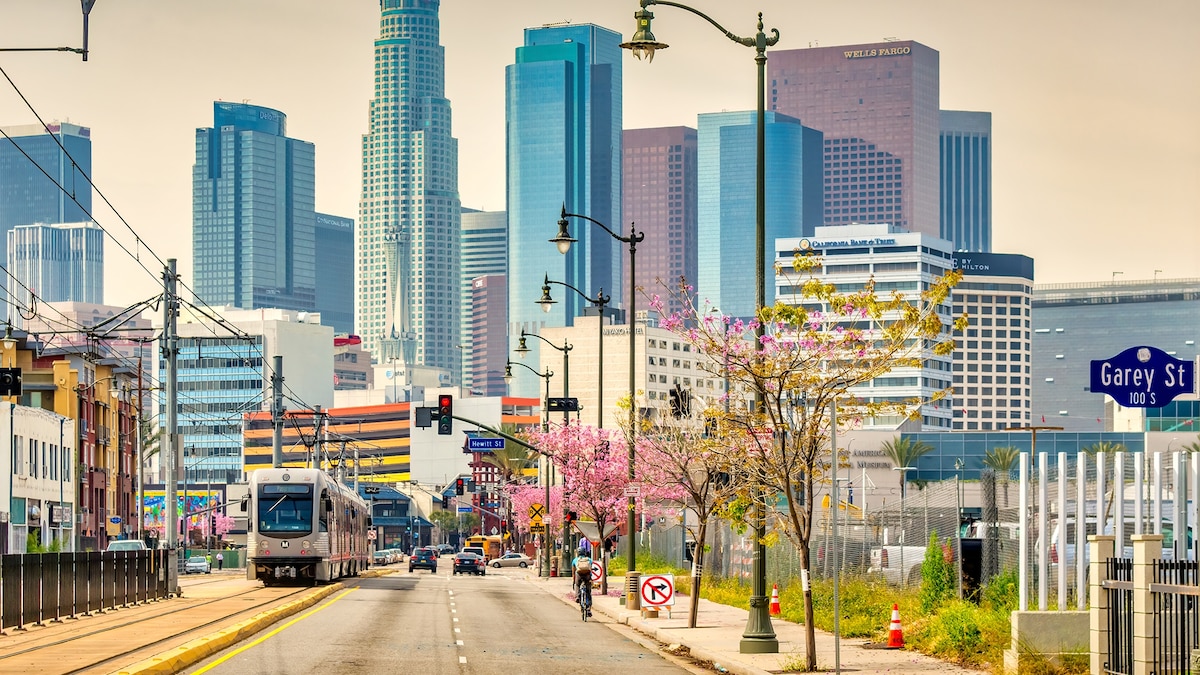This Los Angeles neighbourhood is an enclave of mochi ball bakeries, manga bookshops and cool karaoke bars where you can sing your heart out.
Take a stroll through Little Tokyo, where red paper lanterns hang overhead and kids saunter by in cosplay outfits, and it’s easy to feel like you’re wandering the urban streets of Japan. But a second glance quickly reveals the telltale signs that you’re in the US. Dodgers baseball caps dot the crowd, palm trees sway lazily in the warm breeze and grocery shops display mochi rice balls filled with creamy Southern Californian peanut butter. For all its first impressions, this is the unmistakable heart of downtown Los Angeles.
Just a few walkable blocks south east of Hollywood, this small but mighty neighbourhood has been the epicentre of Japanese-American life for over 140 years, one of only three Japan Towns still remaining in the country. Since 1934, its cultural heritage has been highlighted each August during Nisei Week, a nine-day celebration where pounding drummers and festooned floats parade the streets. Over the last decade or so, a new generation has pinned Little Tokyo to the map in other ways, opening up specialist animation emporiums and top-notch sushi restaurants.
Spearheading the new movement is Little Tokyo Table Tennis, a cult clothing store on First Street where fashion designers have rebranded the pastime of ping pong. The slip of a shop sells upcycled sportswear, hand-stapled sports fanzines and logoed rackets, which you can take along to its weekly games, held on Tuesdays from 6-9pm in the echoey halls of the Terasaki Budokan community centre, a block and a half away. They draw hundreds of enthusiasts, and all levels are welcome to try their hand on the tables; expect pumping house music, and impressive displays of both athletic backspins and retro sportswear.
A couple of doors further along First Street — known as ‘Ramen Row’ with its many noodle joints — is Fugetsu-Do, Little Tokyo’s oldest confectionary shop. Since 1903, the Kito family has been hand-crafting sweet, bean-filled manju cakes and mochi balls, 2,000 of which are made daily in the kitchen at the back, separated from the antique shop counter by a wisp of fabric.
A block away is Azay restaurant, another storied institution. From the outside, it resembles a Parisian bistro, with jaunty cafe curtains and tables spilling out onto the pavement. It’s no accident: the founder, originally from Kyoto, trained in France before opening this local hotspot, where the menu shines a light on both European and Asian dishes. You can’t go wrong by ordering the traditional Japanese breakfast, featuring dainty bowls of fluffy rice, saba mackerel and jiggly cubes of tofu.
Gamers and fashionistas will find much to love in the recently opened Hypland, a block south. The shop is chock-a-block with limited-edition apparel, including Sonic the Hedgehog and Attack on Titan collaborations. There’s also a chill-out area with sofas, computer consoles and some good old-fashioned board games.
Steps away is Japanese Village Plaza, a pedestrianised outdoor shopping hub where, come spring, cherry blossom covers the pavement like confetti. Its labyrinth of alleyways is lined with bubble tea cafes, Japanese bakeries and kawaii gift shops, their shelves heaving under the weight of Hello Kitty collectables. Arrive early at Monkey Pants, a one-in-one-out boutique — the queue can stretch when the latest Sonny Angel dolls drop. At the Gashapon Bandai Official Shop, floor-to-ceiling vending machines dispense miniature Japanese toys. For rare anime figurines, head to Anime Jungle.
Nearby, Kinokuniya bookstore is the place to hunt for manga books and calligraphy art supplies, before a long, lingering lunch at Sushi Takeda. Behind an unassuming door in the Weller Court shopping mall is one of LA’s finest sushi restaurants: its omakase experience invites you to sit back and let chef Hide Takeda lead you through a 16-course culinary journey, sampling slivers of blue fin tuna and slurps of earthy miso soup along the way. The counter has the best seats in the house, offering a front-row view of the chef’s masterful knife work, just within chopstick reach.
For something cheap and cheerful, head to Kura Revolving Sushi Bar where drinks are served by singing robots — a surefire hit with children. Across the street, Somisomi offers goldfish-shaped waffle cones filled with a swirl of soft-serve ice cream. The adjacent Isamu Noguchi Plaza, overlooked by the Japanese American Cultural & Community Center, provides the perfect setting to devour the sweet treat. Its exhibitions and workshops focus on time-honoured Japanese arts, like flower arranging and calligraphy. There’s also the Aratani Theatre for opera, plays and dance performances, and pop-up culinary events in a garden with cascading streams.
As night falls, Lounge Ohjah dazzles as a sleek, low-lit karaoke lounge with plush leather seating, tucked away on the second floor of the Miyako Hotel Los Angeles. With an extensive sake list and a song catalogue spanning both English and Japanese hits, it’s the place to channel your inner J-pop sensation.




